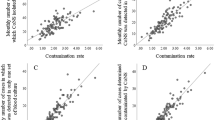Abstract
In order to determine whether a blood culture positive for coagulase-negative staphylococci (CNS) represents bacteremia or contamination, a prospective study was conducted using molecular typing to analyze CNS blood culture isolates and corresponding CNS skin isolates collected after skin disinfection from 431 subjects. CNS bacteremia was not found in any of the 301 subjects not suspected of having bacteremia. In 130 patients suspected of having bacteremia, the rate of actual CNS bacteremia was 6%. The overall rate of CNS blood culture contamination was 1%. Chart analysis showed good agreement between our microbiological definitions of bacteremia and the clinical definitions previously published. Bacteremia and contamination can be differentiated using pulsed-field gel electrophoresis and molecular typing of CNS isolates obtained from cultures of blood and corresponding skin samples.
Similar content being viewed by others
References
Fidalgo S, Vásquez F, Mendoza MC, Pérez F, Méndez FJ (1990) Bacteremia due to Staphylococcus epidermidis: microbiologic, epidemiologic, clinic and prognostic features. Rev Infect Dis 12:520–528
Souvenir D, Anderson DE Jr, Palpant S, Mroch H, Askin S, Anderson J, Claridge J, Eiland J, Malone C, Garrison MW, Watson P, Campbell DM (1998) Blood cultures positive for coagulase-negative staphylococci: antisepsis, pseudobacteremia, and therapy of patients. J Clin Microbiol 36:1923–1926
Viagappan M, Kelsey MC (1995) The origin of coagulase-negative staphylococci isolated from blood cultures. J Hosp Infect 30:217–223
Kirchhoff LV, Sheagren JN (1985) Epidemiology and clinical significance of blood cultures positive for coagulase-negative staphylococcus. Infect Control 6:479–486
Mirrett S, Weinstein MP, Reimer LG, Wilson ML, Reller LB (2001) Relevance of the number of positive bottles in determining clinical significance of coagulase-negative staphylococci in blood cultures. J Clin Microbiol 39:3279–3281
Seo SK, Venkataraman L, DeGirolami PC, Samore MH (2000) Molecular typing of coagulase-negative staphylococci from blood cultures does not correlate with clinical criteria for true bacteremia. Am J Med 109:697–704
Sloos JH, Dijkshoorn L, Vogel L, Boven CP van (2000) Performance of phenotypic and genotypic methods to determine the clinical relevance of serial blood isolates of Staphylococcus epidermidis in patients with septicemia. J Clin Microbiol 38:2488–2493
Ziebuhr W, Heilmann C, Gotz F, Meyer P, Wilms K, Straube E, Hacker J (1997) Detection of the intercellular adhesion gene cluster (ica) and phase variation in Staphylococcus epidermidis blood culture strains and mucosal isolates. Infect Immun 65:890–896
Leonard RB, Carroll KC (1997) Rapid lysis of gram-positive cocci for pulsed-field gel electrophoresis using achromopeptidase. Diagn Mol Pathol 6:288–291
Kloos WE, Bannerman TL (1994) Update on clinical significance of coagulase-negative staphylococci. Clin Microbiol Rev 7:117–140
Sharma M, Riederer K, Johnson LB, Khatib R (2001) Molecular analysis of coagulase-negative staphylococcus isolates from blood cultures: prevalence of genotypic variation and polyclonal bacteremia. Clin Infect Dis 33:1317–1323
Weinbaum FI, Lavie S, Danek M, Sixsmith D, Heinrich GF, Mills SS (1997) Doing it right the first time: quality improvement and the contaminant blood culture. J Clin Microbiol 35:563–565
Herwaldt LA, Hollis RJ, Boyken LD, Pfaller MA (1992) Molecular epidemiology of coagulase-negative staphylococci isolated from immunocompromised patients. Infect Control Hosp Epidemiol 13:86–92
Atela I, Coll P, Rello J, Quintana E, Barrio J, March F, et al (1997) Serial surveillance cultures of skin and catheter hub specimens from critically ill patients with central venous catheters: molecular epidemiology of infection and implications for clinical management and research. J Clin Microbiol 35:1784–1790
Dobbins BM, Kite P, Kindon A, McMahon MJ, Wilcox MH (2002) DNA fingerprinting analysis of coagulase negative staphylococci implicated in catheter related bloodstream infections. J Clin Pathol 55:824–828
Author information
Authors and Affiliations
Corresponding author
Rights and permissions
About this article
Cite this article
Krause, R., Haberl, R., Wölfler, A. et al. Molecular Typing of Coagulase-Negative Staphylococcal Blood and Skin Culture Isolates to Differentiate Between Bacteremia and Contamination. Eur J Clin Microbiol Infect Dis 22, 760–763 (2003). https://doi.org/10.1007/s10096-003-1005-4
Published:
Issue Date:
DOI: https://doi.org/10.1007/s10096-003-1005-4



